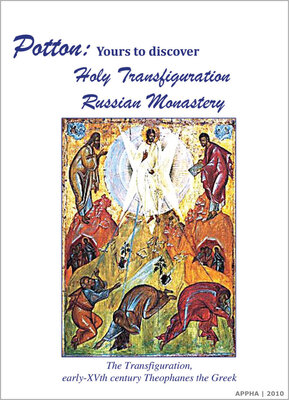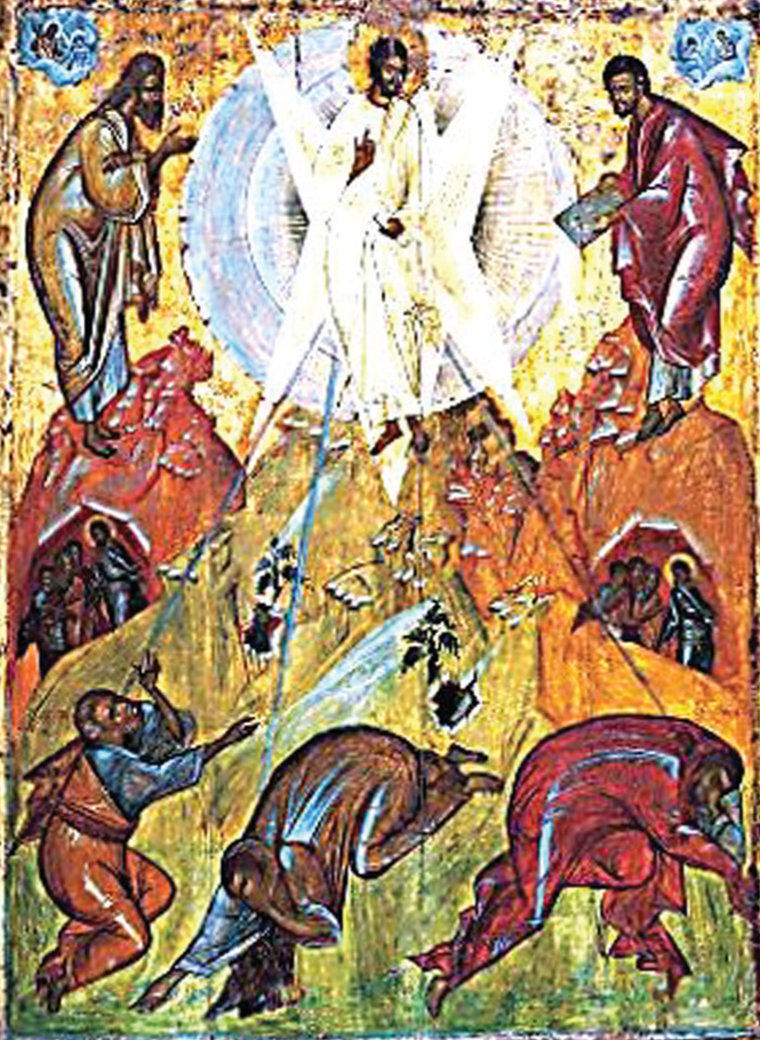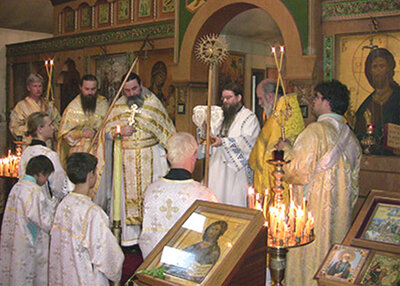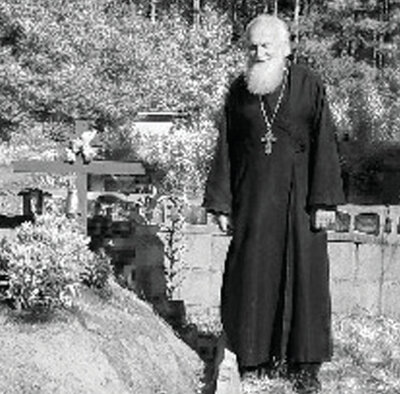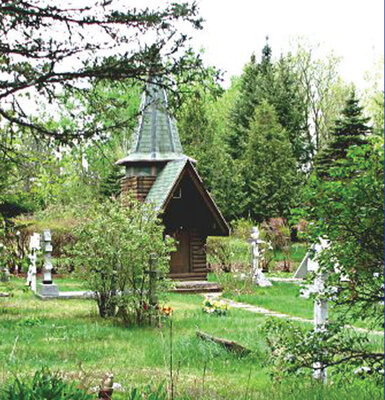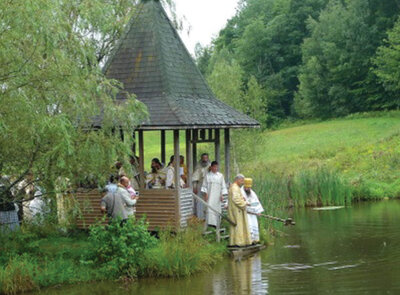Holy Transfiguration Russian Monastery
For a taste of rural Russia in the pastoral setting of Potton, follow Route 243 South to ch. de l’Aéroport, turn onto chemin du Monastère, and follow the Missisquoi River as it winds lazily through fertile pastures to the Holy Transfiguration Russian Orthodox Monastery on the border of Quebec and the State of Vermont.
Above the door of the Monastery Chapel, a mosaic depicts Christ Pantokrator (Παντοκράτωρ) – from Greek, meaning Ruler of All. This typical icon is central to the Eastern Orthodox Church.
The Greek letters o, ω et ν (omikron, omega, and nu) are written in the mosaic of the Christ’s halo, meaning The Being or He who is – indicating the divinity of Christ.
The letters ΙC and ΧC, to the left and right of the head, are an abbreviation of Ιησούς Χριστός, Greek symbols for Jesus Christ.
A bearded Christ, with long hair, is holding the New Testament in his left hand. His right hand, index and middle fingers straight, is slightly raised in a gesture of benediction or that of a teacher.
Inside the church, where the architecture symbolizes the meeting of heaven and earth, is an iconostasis, or wall of holy images set up in a distinct hierarchy. It is a visual reminder of the mystery of faith, and separates the altar and priestly domaine from that of the parish.
Typically, there are no pews in the Russian Orthodox Church. Men stand on the right and women stand on the left – all at equal distance from the altar.
It was in 1959 that the head of the Russian Orthodox Church Outside of Russia, Bishop Vitaly Oustinov, on a visit to Potton, was so enthralled by the landscape of Potton that he bought this 169 acre parcel of land, to establish a retreat for priests and lay members of his community. From the beginning, Archpriest Sergeï Petroff worked diligently to gather parishioners. Construction of the chapel was begun in 1974 and completed in 1979.
Holy Transfiguration Chapel is wood-built, in the Byzantine architectural style of northern Russia, which incorporates the circle, the Oriental symbol for eternity, meaning God. Crowning the steep octagonal spire, is a half circle on which is seated a cylindrical cupola and the gold coloured bulb shaped dome adorned with the cross. The gold colour signifies the heavenly kingdom. The origin of the shape is unknown; however, the widespread use of the dome in northern Russia may simply mean it is well adapted for snowy winters.
In the Orthodox tradition, the Holy Transfiguration represents the eschatological celebration or end times. The transfiguration of Christ occurred when His physical appearance metamorphosed into radiance (in Greek, a transfiguration is a metamorphosis, μεταμόρφωση) and Christ revealed His divine nature, showing that the Kingdom of heaven begins here on earth. Christ spoke with the prophets Moses, who freed the Israelites, and Elijah, who prophesied the Messiah. Three Apostles, Peter, James and John, witnessed the transfiguration of Christ – which prepares Christians for their own resurrection.
Archpriest Sergeï Petroff assured ministry at the Monastery until his death in 2010, at the venerable age of 93. He is buried in the Monastery cemetery beside his wife, Matushka Lidia. Sergeï Petroff was born in St. Petersburg in 1917, and lived in Bulgaria and France before coming to live in Quebec in 1958.
After a 20 year career at l’École polytechnique de Montréal, he entered the priesthood and made Potton his home. In the Orthodox tradition, priests are encouraged to marry. Father Petroff had a daughter and two sons.
His funeral mass was celebrated by the Archbishop of San Francisco and of Western America, in charge of the American Diocese of the Russian Orthodox Church in Exhile.
Burial in the Holy Transfiguration Cemetery is reserved for priests and the laity. It is one of the most impressive in Potton. A Russian Orthodox cross marks each grave. More than fifty-five persons have been buried here since 1969. White crosses mark the graves of individuals without living family at the time of their death.
The Orthodox cross is three barred. The uppermost is symbolic of the title board Pilate ordered to be hung in mockery over Christ’s head at His crucifixion; the second symbolizes the extended arms of the crucified Christ. The lowest bar is slanted and symbolizes a brace for His feet. The origin of this footboard is unknown, but in the symbolism of the Russian Church, the most common explanation is that it is the pointing upward to Paradise for the Good Thief on Jesus' right and downward to Hell for the Thief on His left.
The Russian Orthodox Church in Exile resulted from a split with the Russian Orthodox Church Outside of Russia, in 2001. The former prelate of this Church, His Beatitude Vitaly Oustinov, then retired, headed the opposition to the rapprochement with the Patriarch of Moscow. He became the Metropolitan of the Russian Church in Exile in November of 2001. Vitaly Oustinov was born in St. Petersburg on March 18, 1910 and died in Magog on September 25, 2006 at the age of 96. He is buried in the Cemetery of the Holy Transfiguration Monastery in Potton.
With the death of resident Archpriest Sergeï Petroff, the monastery facility is now rarely used. Visits to the property are allowed provided the private and sacred nature of the place is respected.
Potton is a welcoming place as witnessed by its rich and diverse religious heritage. The Holy Transfiguration Chapel and Cemetery are magnificent examples of this.
Sources
- Leduc, Gérard, et Peter Downman. Monastère russe, Association du patrimoine de Potton, 2002.
- Église orthodoxe russe en exil. www.roca-sobor.org.
- Humbert, Jean-Louis. Donner un sens aux formes des lieux culturels – L’Église orthodoxe, Centre départemental de documentation pédagogique (CDDP) de l'Aube, France, septembre 2001.
- Talbot, Lise-Anne, responsable du site www.saintbenoitdenursie.org
Production team
Research and French text: Jean-Louis Bertrand
Research and English text: Sandra Jewett
Revision: Jacqueline Robitaille
Printed edition © 2010
Web edition: Serge Normand, 2024
